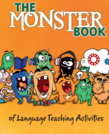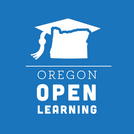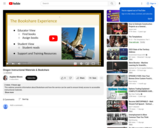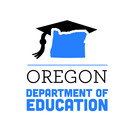
Unit 7 Money Matters: Lessons on Budgeting and Savings
- Subject:
- Economics
- Material Type:
- Unit of Study
- Author:
- Aujalee Moore
- Date Added:
- 05/17/2024

Unit 7 Money Matters: Lessons on Budgeting and Savings

During this lesson, the student(s) will:• Understand the risks of credit cards and how interest rates can increase your credit card balance. • Learn about credit records and the importance of good credit.• Explain why it’s important to pay credit card bills in full and on time.

The Monster Book remains a collection of over 150 activities intended to liven up the language classroom, engage students in learning, and give instructors straightforward, active options for practicing the four skills and tapping into other elements of language such as grammar, vocabulary, critical thinking, and culture.

This tool was designed by the Oregon Open Learning team as a resource to find open-source images when curating OER. Below are two tables that are categorized by image type. If you have questions about this resource, please contact OregonOpenLearning@ode.state.or.us.

Oregon Department of Education's Program Analyst and Instructional Materials Coordinator Aujalee Moore shares the states processes and guidelines for school district purchases of accessible curriculum and supplemental materials for K-12.

This webinar presents information about Bookshare and how the service can be used to ensure timely access to accessible instructional materials.

A slide show that can be used to teach students about cover letter basics.

List of online professional learning opportunities for educators.

Slides about professional skills in the workplace.

The Project Design Rubric uses the Essential Project Design Elements as criteria to evaluate projects. The rubric aligns with PBLWorks' Gold Standard PBL model. Definitions and practical examples are used to clarify the meaning of each dimension.The rubric helps educators understand the difference between a simple "project" and rigorous Gold Standard PBL. Teachers who are new to PBL can see how to move from beginner to expert.You and your colleagues can use the rubric to guide the design of projects, give formative feedback, and reflect and revise.

Presentation about professionalism in the workplace

This lesson introduces the Native American tradition of seasonal rounds and also discusses the important connection between land, food, nutrition, and energy for Native American people in Oregon. Many tribes migrated seasonally, based on the food sources that were available in a given place at a given time. Tribes and smaller bands of Native people would often travel several hundred miles in a few weeks to get to the next food-gathering source in time.In this lesson, students will reflect on their own lives and the foods they eat throughout the year while also learning about the food traditions of Native American people in Oregon. This lesson will also help students understand the close connection that Native Americans in Oregon have with the land.

Students will learn about the concept of food sovereignty and will explore features of the traditional food systems of Native Americans in Oregon and compare them to current food cultivation and consumption practices. Optionally, they can then research and prepare case studies of tribal and intertribal food sovereignty projects in Oregon and analyze the lessons those studies can provide for reducing the impact of human activities on natural systems.

The oral traditions of Native American tribes in Oregon tell the story of continuous existence ofIndigenous people on this land. From the coast to the inland valleys, the Columbia Plateau to theGreat Basin, tribal people have maintained continuous and balanced relationships with Oregon’snatural environment since time immemorial.This connection between Indigenous people and place has always informed their approach to whatis now called land management. Indigenous people had a thorough understanding of seasonal ecosystems and ecoregions, and this knowledge of soil, water, plants, and animals helped themsurvive. Contemporary Native people in Oregon continue to draw on traditional Indigenous knowledge, also known as traditional ecological knowledge, to guide how they manage the land.In this lesson, students will explore the components and processes of traditional ecological knowledge through the lens of contemporary tribal projects being conducted across the state. Students will consider how tribes are stewards of their lands and natural resources and how they leverage their resources by collaborating with nonprofit and government agencies.

This lesson examines tribal stewardship of natural resources and the concept of a federal trust relationship between tribes and the U.S. government. More than a century of federal policy denied tribes the rights to control and manage the lands that were set aside for them as part of treaty negotiations. These lands are legally owned by tribes and Native American individuals but are held in trust by the U.S. government. In recent decades, tribes have fought and won many legal battles to establish the right to manage the natural resources on tribal land, as well as the right to hunt, fish, and use those resources in accordance with their traditions. Today, tribal agencies frequently collaborate with both state and federal government agencies, such as the Oregon Department of Fish and Wildlife and the U.S. Forest Service, to manage and protect the land.

In this lesson students will learn how Native American tribes living in what is now Oregon incorporated geologic knowledge into their lifeways and cultures. It will describe tribes’ use of stone tools, designation of prominent landforms as significant and meaningful places, and oral traditions they maintained regarding geologic events to help them understand and organize the world they lived in. This lesson assumes students have some familiarity with or prior instruction in earth science concepts such as Oregon landforms, the rock cycle, plate tectonics, and earthquakes and tsunamis.

The annual cycle of seasonal rounds for Native Americans in Oregon reflects the relationship theyshare with the land—a relationship that includes intimate knowledge of local ecosystems. Since time immemorial, Tribes in Oregon have carefully considered seasonal ecosystems and ecoregions, and this knowledge of soil, water, plants, and animals helped them survive. Native Americans in Oregon today continue to draw on traditional Indigenous knowledge to guide how they manage the parts of their ancestral homelands that remain in their care.In this lesson, students will use a systems-thinking approach to explore the components andprocesses of ecosystems as they consider how the seasonal rounds of Native American Tribes in Oregon reflect local ecosystems. Students will analyze a hypothetical and a local ecosystem by identifying abiotic and biotic components and their relationships and then consider how Native people in Oregon considered the local abiotic and biotic components of their seasonal ecosystemsin seasonal rounds. Students will also consider the impact of forced relocation to reservations. Prior to white settlement, most Tribes in Oregon moved seasonally throughout a vast region in a pattern based on the availability of foods. Students will consider habitats, natural resources, stability and change, and living and nonliving components of habitats.

Self-advocacy is a challenging task because it requires us to be vulnerable and express what is most important to us, often at the risk of negative consequences or backlash. This activity helps students to learn self-advocacy through storytelling.

With the passage of Senate Bill 3, beginning with the class of 2027, the Oregon diploma requirements will include 0.5 credit in Personal Financial Education and 0.5 credit in Higher Education and Career Path Skills. Visit the Overview to learn more about these new requirements.

Slides that can be used and adapted to teach students about preparing resumes and cover letters.